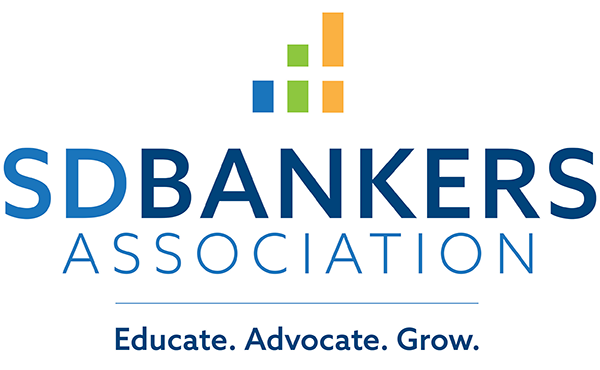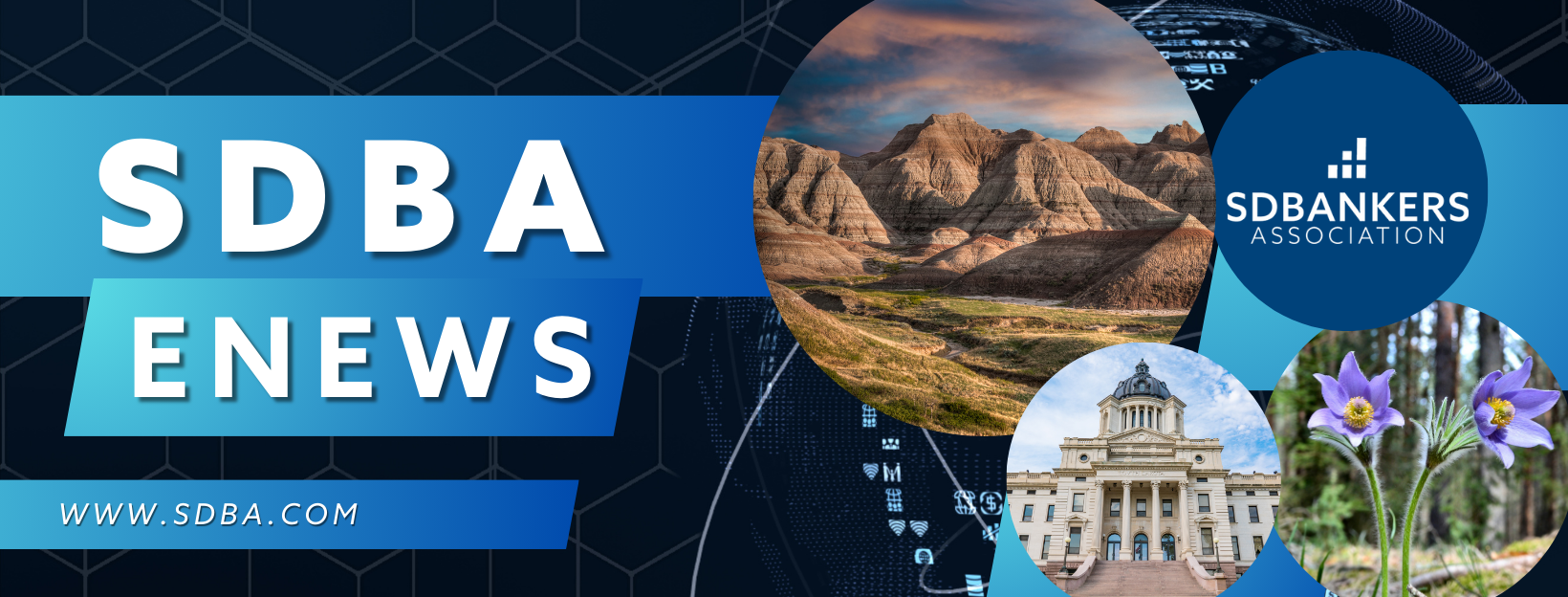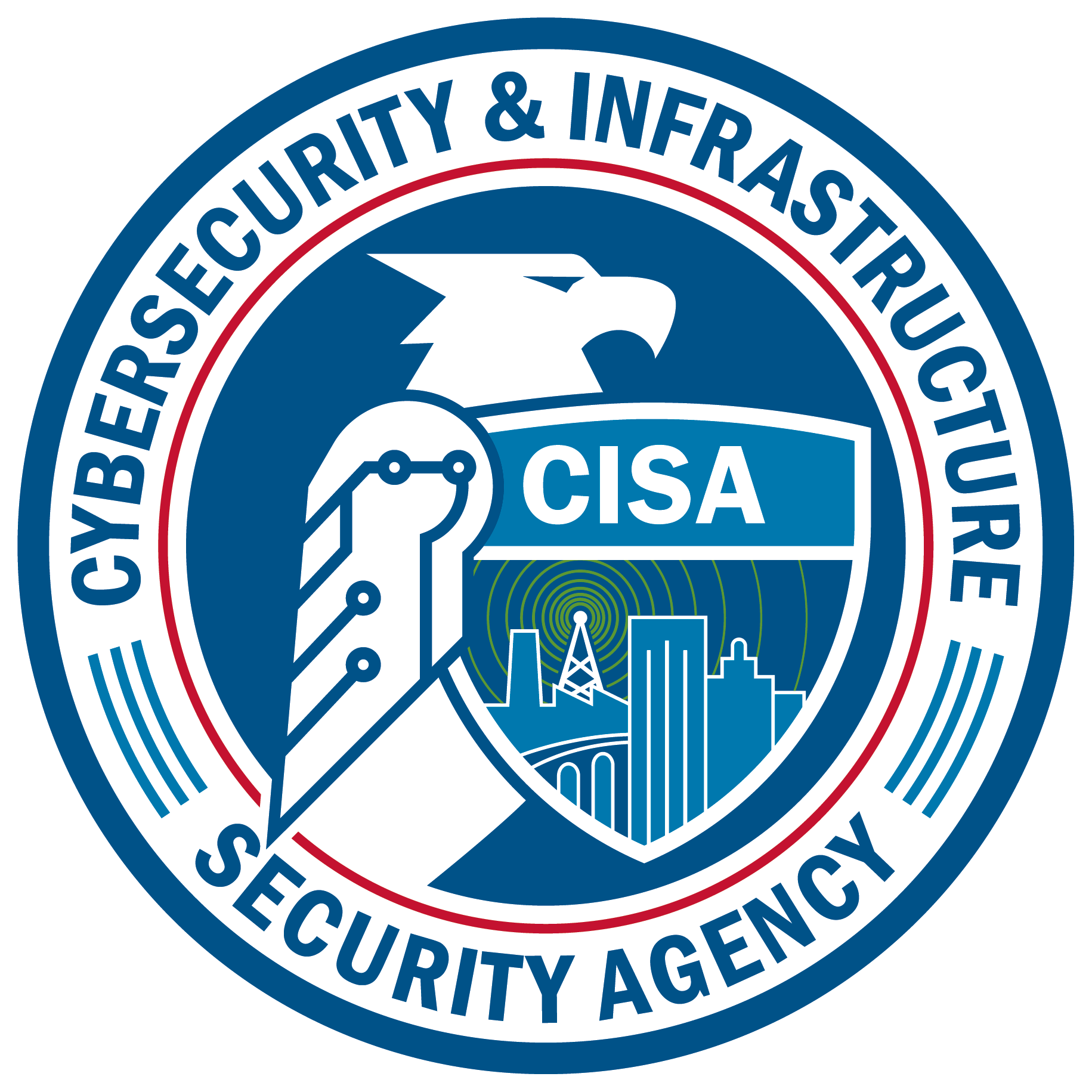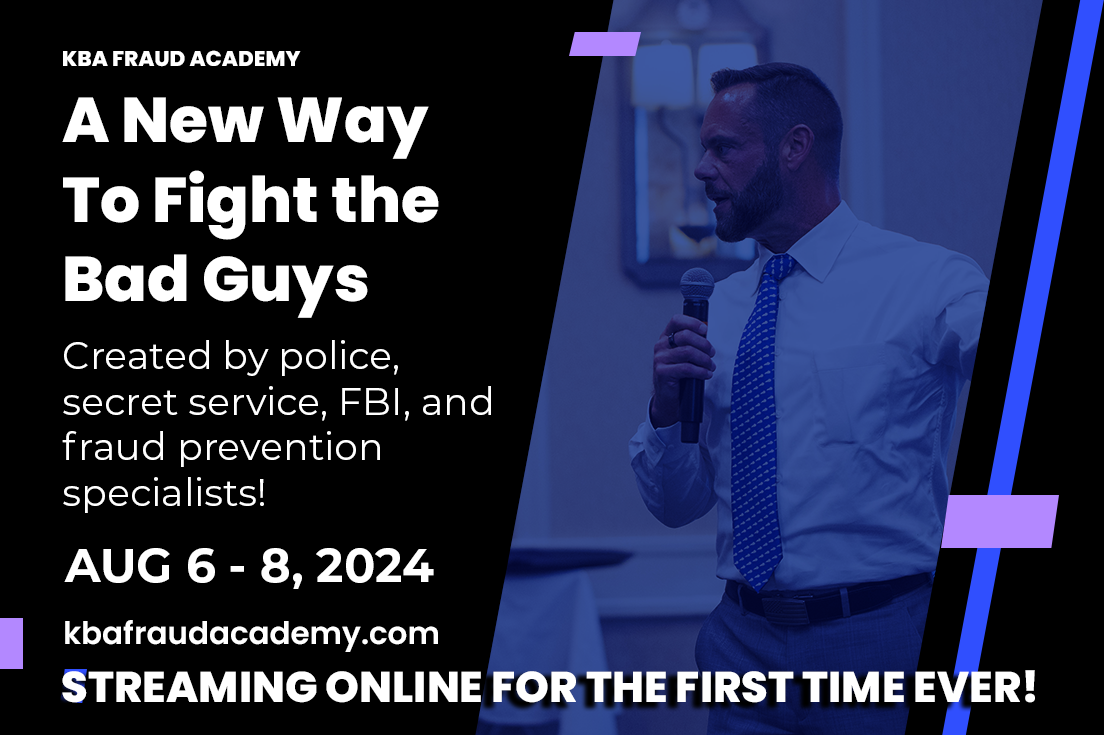- Education & Events
- Advocacy
- Products & Services
- Membership
- Resources
- SDBANKER Magazine
- SDBA eNews
- SDBA eNews Archives
- Legislative Update/Bill Watch
- South Dakota Bank Directory
- Women in Banking
- Scenes of South Dakota Calendar*
- Holiday Signs
- Regulatory Report
- South Dakota Banking Code
- Record Retention Manual
- Advertising & Sponsorship Guide
- COVID-19 Resources
- Mental Health and Crisis Prevention
- About
|
ABA Newsbytes: Nichols: ABA Fighting 'Regulatory Tsunami' on Behalf of Banking IndustryFrom the Basel III endgame to interchange proposals being considered by both Congress and the Federal Reserve, to a wave of unwarranted and unfounded CFPB rules and new state-based challenges to national bank preemption, banks are facing a "regulatory tsunami," ABA President and CEO Rob Nichols said in his midyear recap to member bank CEOs. Amid the rising tide, ABA is standing up for the industry on every front, he added. ABA Banking Journal: ABA, Trade Groups Ask CFPB to Consider Small Firms’ Needs as it Finalizes Section 1033 RuleJune 12, 2024 ABA, along with the American Fintech Council and the Community Development Bankers Association, sent a letter today to the CFPB urging the bureau to consider the unique position of small banks and fintech firms in complying with the requirements outlined in its proposed rule on personal financial data rights. The CFPB last year issued a proposed rule to implement Section 1033 of the Dodd-Frank Act, which requires businesses to make a consumer’s financial information available to them or a third party at the consumer’s direction. “The technical complexity of Section 1033 operationalization, the need to understand the context of the ecosystem’s historical development, and the tangled spiderweb of overlapping laws and existing entity-specific solutions renders the [compliance] challenge especially arduous,” the associations wrote, adding that several sections of the proposed rule are “unclear and inconsistent” and would benefit from “practical implementation advice.” The groups also asked that the CFPB be sure to incorporate stakeholder feedback as it finalizes the rule to “reduce ambiguity” and to ensure “an effective rollout that limits disruptions to consumers.” The trade groups referenced the Small Business Regulatory Enforcement Act, which requires that agencies “explain the actions a small entity is required to take to comply” including a “description of actions needed to meet the requirements of a rule, to enable a small entity to know when such requirements are met.” They also provided a list of issues that should be included in a guide specifically catering to the needs of smaller firms. “It is imperative that the CFPB have consistent expectations for the ecosystem and not establish a bifurcated compliance regime for substantive provisions of the rule that are applicable to both small and large entities,” the groups wrote. CISA NEWS: AI is Helping Scammers Outsmart You -- and Your BankYour ‘spidey sense’ is no match for the new wave of scammers.Dalvin Brown and Katherine Hamilton | June 22, 2024
Artificial intelligence is making scammers tougher to spot. Gone are the poorly worded messages that easily tipped off authorities as well as the grammar police. The bad guys are now better writers and more convincing conversationalists, who can hold a conversation without revealing they are a bot, say the bank and tech investigators who spend their days tracking the latest schemes. ChatGPT and other AI tools can even enable scammers to create an imitation of your voice and identity. In recent years, criminals have used AI-based software to impersonate senior executives and demand wire transfers. “Your spidey senses are no longer going to prevent you from being victimized,” said Matt O’Neill, a former Secret Service agent and co-founder of cybersecurity firm 5OH Consulting. In these recent cases, the frauds are often similar to old scams. But AI has enabled scammers to target much larger groups and use more personal information to convince you the scam is real. Fraud-prevention officials say these tactics are often harder to spot because they bypass traditional indicators of scams, such as malicious links and poor wording and grammar. Criminals today are faking driver’s licenses and other identification in an attempt to open new bank accounts and adding computer-generated faces and graphics to pass identity-verification processes. All of these methods are hard to stave off, say the officials. JPMorgan Chase has begun using large-language models to fight identity fraud. Carisma Ramsey Fields, vice president of external communications at JPMorgan Chase, said the bank has also stepped up its efforts to educate customers about scams. ABA Newsbytes: OCC Proposes New Recovery Plan Requirements for $100M-plus BanksJune 24, 2024
Read full article. Read the proposed rule. Read the current guidelines. 2024 SDBA Ag Credit Conference
The 2024 SDBA Agricultural Credit Conference brings together key stakeholders in the financial and agricultural sectors to address pertinent issues surrounding agricultural financing and credit access. This conference serves as a platform to explore emerging trends, address common challenges, and identify opportunities for collaboration and partnership to support the long-term success and resilience of the agricultural sector. Through expert presentations, insightful discussions, panel discussions and a robust exhibit hall, attendees will gain valuable insights into navigating the challenges of agricultural lending, mitigating risks, and maximizing opportunities for growth in this vital sector of the economy. 2024 Virtual Understanding Bank PerformanceProviding a Strong Foundation for the Next Generation of BankersJuly 9, 11, 16, 18, 23, 25, 30, Aug 1 | 10 a.m. - 12 p.m. CDT

Participants will learn how to assess and analyze a bank’s financial performance by working with data from real institutions. Using financial statements from one sample financial institution along with statements from their own banks, participants will become familiar with the ins and outs of balance sheets and income statements and learn how to apply key performance metrics to the data presented in these documents.
Having learned how to interpret and analyze a bank’s financial statements, participants will gain deeper insight into the factors affecting bank performance. Later sessions in this course will address ways in which performance may be hindered or improved by funding strategies and risk management. Ultimately, participants will be able to review a bank’s financial statements to identify strengths and weaknesses and be able to recommend changes that will lead to improved performance.
In the final session of this course, participants will put what they have learned into practice. Participants will analyze a new data set, rate the bank’s performance and suggest strategic adjustments that might benefit the bank. 2024 Fraud AcademyAugust 6-8, 2024 | Virtual
The Fraud Academy is a “first of its kind” two-day school that will train employees at all levels of your institution on fraud risk and what they can do fight it. This program will feature speakers from the United States Secret Service, attorneys from the United States for the Eastern District of Kentucky, Lexington Police Department, and other current and former law enforcement experts that will share their experiences and insights to best educate your bankers on how to mitigate fraud risk and ultimately reduce your fraud loss. Question of the WeekQ: Under Regulation E § 1005.6(b)(1) and§ 1005.6(b)(2), a consumer’s liability is limited in relation to the learning of the loss or theft of an ”access device.” What exactly is an access device? A: An access device is not just limited to a debit card itself, but also includes personal identification numbers (PINs), telephone transfer and telephone bill payment codes, and other means that may be used by a consumer to initiate an electronic fund transfer (EFT) to or from a consumer account. The term does not include magnetic tape or other devices used internally by a financial institution to initiate electronic transfers, nor does it include a check or draft used to capture the Magnetic Ink Character Recognition (MICR) encoding to initiate a one-time automated clearinghouse (ACH) debit. Comment 2(a)-1 Learn how to put compliance management solutions from Compliance Alliance to work for your bank, by contacting (888) 353-3933 or [email protected] and ask for our Membership Team. For timely compliance updates, subscribe to Bankers Alliance’s email newsletters. SDBA eNews Archive Advertising Opportunity Questions/Comments |






